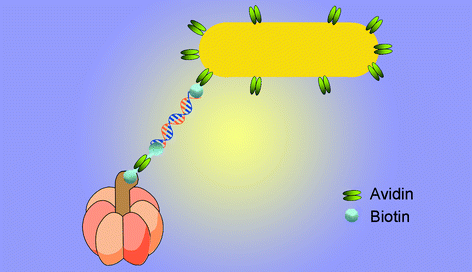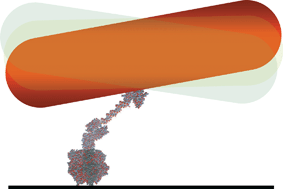In the near future a bio-sensing nano-device developed by Arizona State University researcher Wayne Frasch could eliminate long lines at airport security checkpoints and revolutionize health screenings for diseases like anthrax, cancer and antibiotic resistant Staphylococcus aureus (MRSA) - and it will all happen with the world’s tiniest rotary motor.
Frasch works with the enzyme F1-adenosine triphosphatase, better known as F1- ATPase. This enzyme, only 10 to 12 nanometers in diameter, has an axle that spins and produces torque. This tiny wonder is part of a complex of proteins key to creating energy in all living things, including photosynthesis in plants. F1-ATPase breaks down adenosine triphosphate (ATP) to adenosine diphospahte (ADP), releasing energy. Previous studies of its structure and characteristics have been the source of two Nobel Prizes awarded in 1979 and 1997.

It was through his own detailed study of the rotational mechanism of the F1-ATPase, which operates like a three-cylinder Mazda rotary motor, that Frasch conceived of a way to take this tiny biological powerhouse and couple it with science applications outside of the human body.
What Frasch and his colleagues show is that the enzyme can be armed with an optical probe (gold nanorod) and manipulated to emit a signal when it detects a single molecule of target DNA. This is achieved by anchoring a quiescent F1-ATPase motor to a surface. A single strand of a reference biotinylated DNA molecule is then attached to its axle. The marker protein, biotin, on the DNA is known to bind specifically and tightly to the glycoprotein avidin, so an avidin-coated gold nanorod is then added. The avidin-nanorod attaches to the biotinylated DNA strand and forms a stable complex.
When a test solution containing a target piece of DNA is added, this DNA binds to the single complementary reference strand attached to the F1-ATPase. The DNA complex, suspended between the nanorod and the axle, forms a stiff bridge. Once ATP is added to the test solution, the F1-ATPase axle spins, and with it, the attached (now double-stranded) DNA and nanorod. The whirling nano-sized device emits a pulsing red signal that can then be detected with a microscope.
According to Frasch, the rotation discriminates fully assembled nanodevices from nonspecifically bound nanorods, resulting in a sensitivity limit of one zeptomole (600 molecules). Simply put, if it’s not moving and flashing, it simply isn’t relevant.
Moreover, Frasch says, “Studies with the F1-ATPase in my laboratory show that since it can detect single DNA molecules, it far exceeds the detection limits of conventional PCR [polymerase chain reaction] technology.”
Such a detection instrument based on the F1-ATPase enzyme would also be “faster and more portable,” he adds.

With support from Science Foundation Arizona (SFAz), Frasch will transfer his work from the bench to biotech, through establishment of a local company that utilizes the nano-sized F1-ATPase to produce a DNA detection instrument.
A prototype of the DNA detector is already in development. It is roughly the size of a small tissue box. Sampling would be as simple as taking a swab from an infected wound or a piece of baggage, dissolving it in a solution and placing a drop on a slide bearing reference F1-ATPases and their nanorods. Once in the instrument, red blinking signals emitted by rotating nanorods would let a computer know there’s trouble, literally, in a flash.
SFAz funding has also enabled Frasch to extend the method to do protein detection at the single molecule level. This is novel because, unlike DNA, proteins can not be amplified artificially to improve the chances of detection.
“Rapid and sensitive biosensing of nucleic acids and proteins is vital for the identification of pathogenic agents of biomedical and bioterrorist importance,” notes Frasch, who is also with the Center for Bioenergy and Photosynthesis in the College of Liberal Arts and Sciences. “It also provides a new avenue through which to analyze genotypes and forensic evidence.”
Article: J. York, D. Spetzler, F. Xiong and W. D. Frasch, 'DNA detection with a twist', Lab Chip, 2008, 8, 415–419 DOI: 10.1039/b716744j





Comments